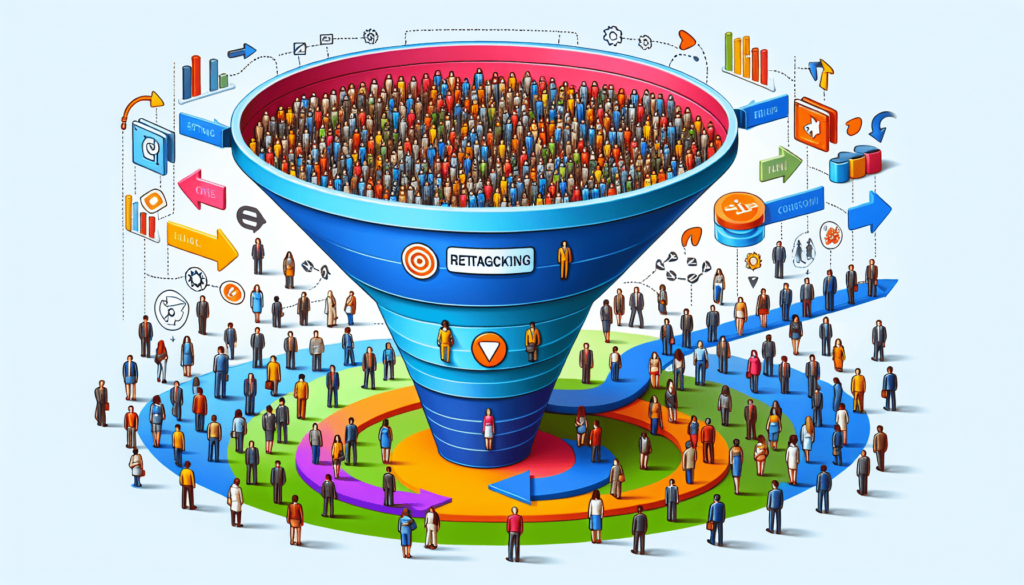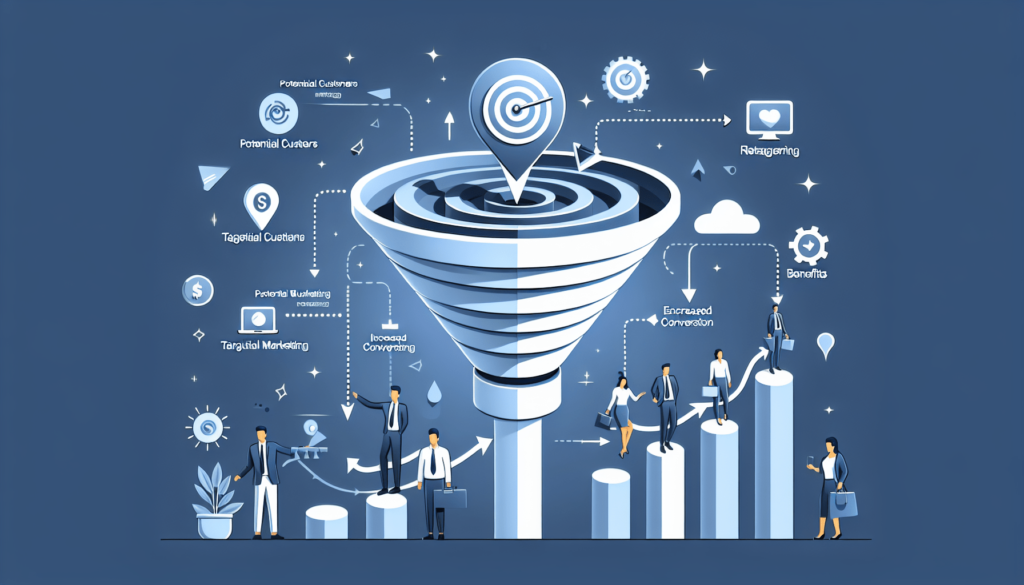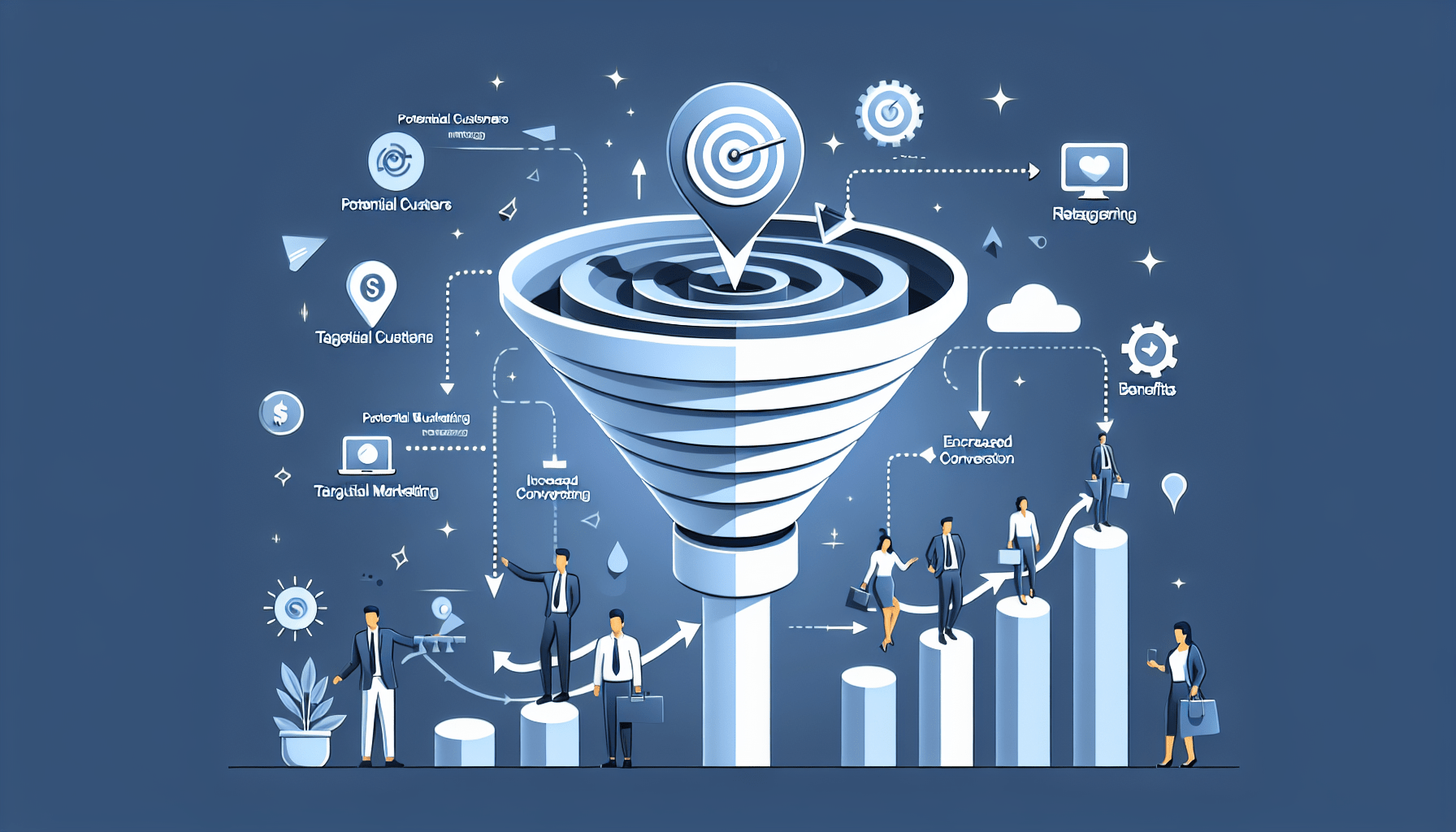In the world of digital marketing, retargeting has become an invaluable tool for businesses looking to maximize their sales funnel. By strategically targeting individuals who have previously shown interest in your product or service, retargeting allows you to re-engage with potential customers and guide them towards making a purchase. In this article, we will explore the various ways you can leverage retargeting in your sales funnel, helping you to boost conversions and ultimately increase your revenue. So buckle up and get ready to discover the power of retargeting in driving your business forward!
Understanding the Sales Funnel
The sales funnel is a model that depicts the customer’s journey from the initial stage of awareness about a product or service to the final stage of taking action, such as making a purchase. It is divided into four main stages: Awareness, Interest, Desire, and Action.
Awareness
In the awareness stage, potential customers become aware of a product or service through various marketing channels such as social media, search engines, or offline advertising. At this stage, it is crucial to make a strong first impression and capture the attention of your target audience.
Interest
Once potential customers are aware of your product or service, they enter the interest stage. In this stage, they are actively seeking more information and evaluating options. It is important to provide valuable content and engage with them to maintain their interest.
Desire
As potential customers move into the desire stage, they have developed a strong interest in your product or service. They envision how it could benefit them and are more likely to make a purchase. It is essential to highlight the unique selling points and value proposition to help solidify their desire.
Action
The action stage is the final step in the sales funnel. At this point, potential customers have made the decision to purchase and are ready to take action. This is where they convert into paying customers, whether it’s making a purchase, signing up for a service, or taking any other desired action.
What is Retargeting?
Retargeting, also known as remarketing, is a marketing strategy that allows you to re-engage with potential customers who have previously shown interest in your product or service. It works by tracking users’ online behavior and displaying targeted advertisements to them across various platforms.
Definition
Retargeting involves using cookie-based technology to track users who have visited your website or interacted with your brand in some way. These users are then targeted with specific advertisements to remind them of your offerings and encourage them to take action.
Benefits
There are several benefits to incorporating retargeting into your marketing strategy. Firstly, it helps to increase brand recall and stay top of mind for potential customers. Additionally, retargeting allows you to reach a highly engaged audience who has already shown interest, increasing the chances of conversion. It also provides the opportunity to personalize advertisements based on users’ previous interactions, enhancing the user experience.
Types of Retargeting
There are different types of retargeting strategies that you can implement based on your objectives and target audience. Website retargeting involves targeting users who have previously visited your website. Search retargeting targets users who have searched for specific keywords related to your products or services. Social media retargeting involves targeting users who have previously engaged with your brand on social media platforms.

Setting Goals for Retargeting
Before implementing a retargeting strategy, it is essential to define your goals and objectives to ensure you are effectively leveraging this marketing tactic.
Increasing Conversions
One of the primary goals of retargeting is to increase conversions. By targeting users who have already shown interest, you have a higher likelihood of converting them into paying customers. Set specific conversion targets and track the results to measure the success of your retargeting campaigns.
Increasing Customer Lifetime Value
Retargeting can also be used to increase the lifetime value of your customers. By re-engaging with past customers, you can encourage repeat purchases, promote upsells or cross-sells, and build long-term relationships with your audience.
Building Brand Awareness
Retargeting is not just about driving immediate conversions. It can also be used as a tool to build brand awareness and stay top of mind for potential customers. By consistently displaying your brand and messaging to your target audience, you can increase brand recall and familiarity.
Identifying Retargeting Segments
To effectively retarget your audience, you need to identify specific segments based on their behavior and characteristics. This allows you to tailor your advertisements and messaging to resonate with each segment.
Segmentation Criteria
Segmentation criteria can include various factors such as website behavior, engagement level, demographics, or past purchase history. By segmenting your audience, you can create more personalized and targeted retargeting campaigns that speak directly to their needs and interests.
Using Customer Data
Leveraging customer data is key to identifying retargeting segments. Analyze your existing customer data to understand their preferences, behaviors, and purchase patterns. This data can help you create segments based on specific criteria and improve the effectiveness of your retargeting efforts.
Creating Custom Audiences
Custom audiences allow you to retarget users based on specific criteria or actions. Platforms such as Facebook and Google Ads provide options to create custom audiences using parameters such as website visitors, email subscribers, or users who have interacted with specific content. Creating custom audiences helps you deliver highly relevant advertisements to the right people.

Creating Compelling Retargeting Ads
Creating compelling retargeting ads is crucial to capture the attention and interest of your target audience. Here are some key elements to consider when crafting your ads:
Captivating Headlines
Your ad headlines should be attention-grabbing and compelling. Use concise and clear language to entice users to click on your ad and learn more about your offering. A strong headline can make all the difference in getting users to engage with your retargeting campaign.
Compelling Visuals
Visual elements play a significant role in attracting and engaging users. Choose high-quality images or videos that are visually appealing and relevant to your offering. Visuals should be eye-catching and align with your brand identity to create a cohesive user experience.
Clear Call-to-Action
A clear call-to-action is essential to guide users towards the desired action. Incorporate a strong and actionable CTA that tells users what they need to do next, such as “Shop Now” or “Learn More.” Make sure the CTA stands out and is easily clickable for a seamless user experience.
Optimizing Landing Pages for Retargeting
Once users click on your retargeting ad, it is essential to optimize the landing page they are directed to. Here are some tips for optimizing your landing pages for retargeting campaigns:
Consistency with Ads
Ensure that the messaging and visuals on your landing page are consistent with the corresponding retargeting ad. This creates a seamless transition for users and reinforces the message or offer they initially engaged with.
Personalization
Customize your landing pages based on the retargeting segment you are targeting. Personalization can include displaying relevant product recommendations, tailored offers, or personalized messaging directly addressing the user’s interests or needs.
Clear Conversion Path
Make it easy for users to take the desired action by providing a clear conversion path. Eliminate any distractions or unnecessary steps that could hinder the conversion process. Use persuasive copy and visuals to guide users towards the conversion goal.
Implementing Retargeting Pixels
Retargeting pixels are an essential part of implementing retargeting campaigns. They allow you to track user behavior and gather data to optimize your retargeting efforts.
What are Pixels?
Pixels are small pieces of code that are placed on your website to track user behavior. They collect data on users who visit your website and enable you to retarget them with relevant ads later on.
Placing Pixels on Your Website
To start using retargeting pixels, you need to place the corresponding code on your website. Platforms such as Facebook and Google Ads provide detailed instructions on how to generate and install these pixels. It is crucial to ensure proper installation to track user behavior accurately.
Choosing the Right Pixel
Different retargeting platforms offer various types of pixels, depending on your goals and objectives. Some pixels allow you to track general website visitors, while others provide more specific tracking capabilities, such as tracking users who have added items to a shopping cart but did not complete the purchase. Choose the pixel that aligns with your retargeting strategy and objectives.
Crafting an Effective Retargeting Strategy
Crafting an effective retargeting strategy involves careful planning and consideration of various factors. Here are some key steps to follow when creating your strategy:
Defining Objectives
Clearly define your objectives and KPIs for your retargeting campaigns. Whether it’s increasing conversions, building brand awareness, or improving customer lifetime value, having well-defined objectives will guide your strategy.
Selecting Ad Platforms
Determine which ad platforms align with your target audience and marketing goals. Popular platforms for retargeting include Facebook Ads, Google Ads, and LinkedIn Ads, among others. Consider factors such as reach, targeting options, and budget to select the right platforms for your campaigns.
Setting Budgets and Frequency Caps
Allocate budgets for your retargeting campaigns based on your overall marketing budget and objectives. Setting frequency caps ensures that you do not overwhelm users with too many ads, which could lead to ad fatigue or a negative user experience. Choose appropriate frequency caps to strike the right balance in your retargeting efforts.
Measuring and Analyzing Retargeting Performance
Measuring and analyzing the performance of your retargeting campaigns is crucial to understanding their effectiveness and optimizing for better results. Here are some key aspects to focus on:
Key Performance Indicators
Identify the key performance indicators (KPIs) that align with your objectives and track them regularly. KPIs could include conversion rate, click-through rate (CTR), return on ad spend (ROAS), or cost per acquisition (CPA). Monitoring these indicators helps you gauge the success of your retargeting campaigns.
Conversion Tracking
Implement conversion tracking to measure the number of users who take the desired action after being retargeted. This allows you to attribute conversions directly to your retargeting efforts and optimize your campaigns accordingly.
A/B Testing
A/B testing involves testing different variations of ads, landing pages, or targeting strategies to determine which performs better. Continuously test and refine your retargeting campaigns to optimize for improved results. Test different elements such as headlines, visuals, CTAs, or audience segments to find the winning combination.
Retargeting Best Practices
To make the most of your retargeting efforts, here are some best practices to keep in mind:
Avoiding Ad Fatigue
Ad fatigue can occur when users are repeatedly targeted with the same ad over an extended period. To avoid this, regularly refresh your ad creative and rotate different variations. This keeps the ads fresh and prevents users from becoming disengaged or irritated.
Using Frequency Caps
Setting frequency caps helps to control the number of times a user sees your retargeting ads. Strike a balance between being visible enough to stay top of mind while not overwhelming users with too many ads. Find the sweet spot for frequency caps based on your audience’s preferences and behavior.
Leveraging Dynamic Ads
Dynamic ads allow you to dynamically display personalized content to users based on their behavior or preferences. These ads automatically populate content such as product recommendations or offers based on user interactions. Leveraging dynamic ads can significantly increase engagement and relevance for users.
In conclusion, leveraging retargeting in your sales funnel can significantly enhance your marketing efforts. By understanding the sales funnel and implementing a well-defined retargeting strategy, you can effectively re-engage with potential customers, increase conversions, and build brand awareness. Remember to continuously measure and analyze the performance of your retargeting campaigns, and follow best practices to maximize your results.

